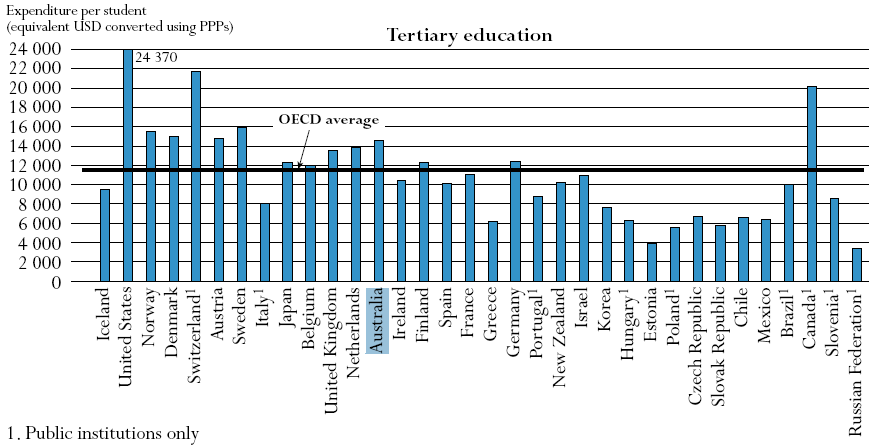|
|
|
|
|
|
|
News & Views item - September 2008 |
![]() Education at a Glance 2008: OECD Indicators Published Today.
(September 10, 2008)
Education at a Glance 2008: OECD Indicators Published Today.
(September 10, 2008)
According to the description on their webpage: "The indicators look at who participates in education, what is spent on it and how education systems operate and at the results achieved. The latter includes indicators on a wide range of outcomes, from comparisons of students’ performance in key subject areas to the impact of education on earnings and on adults’ chances of employment."
The 528 page publication is available online in pdf format [click here, 5.5 Mbytes]
A few points with respect to Australia:
At the tertiary level, the financing patterns that have emerged differ from those in primary and secondary education. First of all, the use of private funds is much more common than at the primary and secondary levels. Private funding represents on average 27% of total spending, exceeds the 50% mark in Australia, Japan, the United States and the partner country Israel, and reaches over 75% in Korea and the partner country Chile (Indicator B3).
[C]ountries such as Australia, Canada, Japan, Korea, New Zealand, the United Kingdom and the United States have expanded participation in tertiary education by shifting some of the financial burden to students and their families.
Australia and New Zealand, for example, supplement income contingent loan schemes for tuition fees, which are available to all students, with means tested income support for living expenses and scholarships to assist with general education and accommodation costs that target lower socio-economic background students.
The proportion of the workforce in skilled professions surpasses the proportion in semi-skilled occupations in the Netherlands and Luxembourg, and, given current growth in skilled occupations among OECD countries, it is only a matter of time before this is also true in Australia, Belgium, Switzerland and the partner country Israel.
In 2006, in Australia, Finland, Hungary, Iceland, New Zealand, Norway, Poland, the Slovak Republic and Sweden, and the partner country the Russian Federation, it is estimated that 65% and more of young adults will enter tertiary-type A programmes.
Tertiary-type A graduation rates range from 20% or less in Greece and Turkey to more than 45% in Australia, Finland, Iceland, New Zealand and Poland.
In Australia, Germany, Switzerland and the United Kingdom, more than 30% of tertiary-type A second degrees or advanced research degrees are awarded to international students. This pattern implies that the true domestic graduate output is significantly overestimated as a proportion of overall graduation rates.
Examining the number of science (engineering, manufacturing and construction, life sciences, physical sciences and agriculture, mathematics and computing) graduates per 100 000 25-to-34-year-olds in employment provides another way of gauging the recent output of high-level skills from different education systems. The number of science graduates (all tertiary levels) per 100 000 employed persons ranges from below 800 in Hungary to above 2,200 in Australia, Finland, France, Ireland, Korea, New Zealand and the United Kingdom...

In all OECD countries for which comparable data are available, private funding on educational institutions [at all levels] represents around 14% of all funds on average... in Australia and Canada, as well as in the partner country Israel, private funds constitute around one-quarter of all educational expenditure. They exceed 30% in Japan, Korea and the United States and the partner country Chile.
And a comment from the federal Minister for Education Julia Gillard talking with David & Kim, Channel 10, Wednesday, 10 September 2008
[W]hat the 2005 figures [from the OECD report Education at a Glance - 2008] clearly show is that we’re spending less than the OECD average on education. We’re coming 19th out of 28 countries—that’s not good... And we’re particularly down the bottom of the class when it comes to investment in early childhood, those vital early learning years. And we’re underperforming when comes to vocational education and training and higher education. So we’ve got to do more right across the board. I mean what this OECD report is telling us is that we do need an education revolution. We’re starting on that revolution with more investments in early childhood, more investments in vocational education and training and universities, and we’re working on a lot more resources for schools, particularly in discussions with our state and territory colleagues.